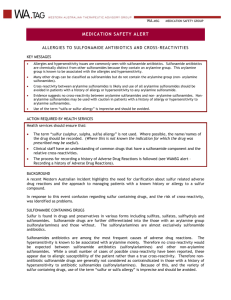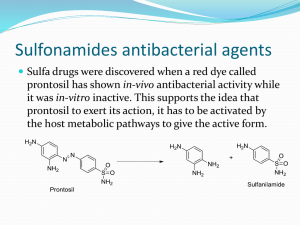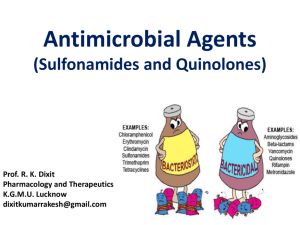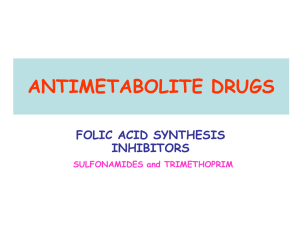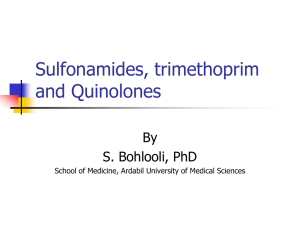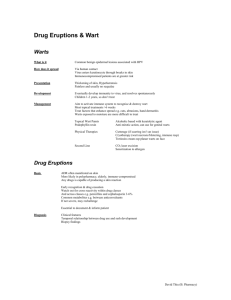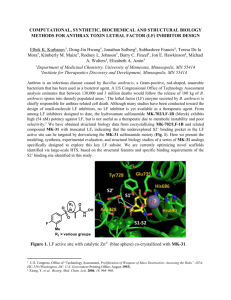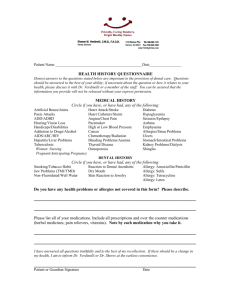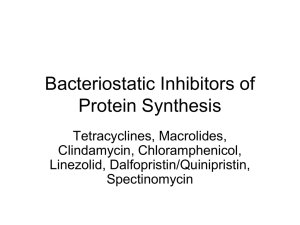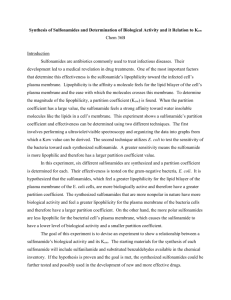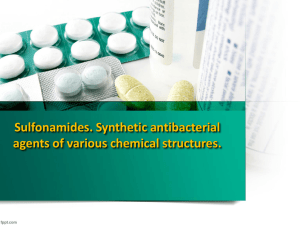sulfonamide cross-reactions explained
advertisement
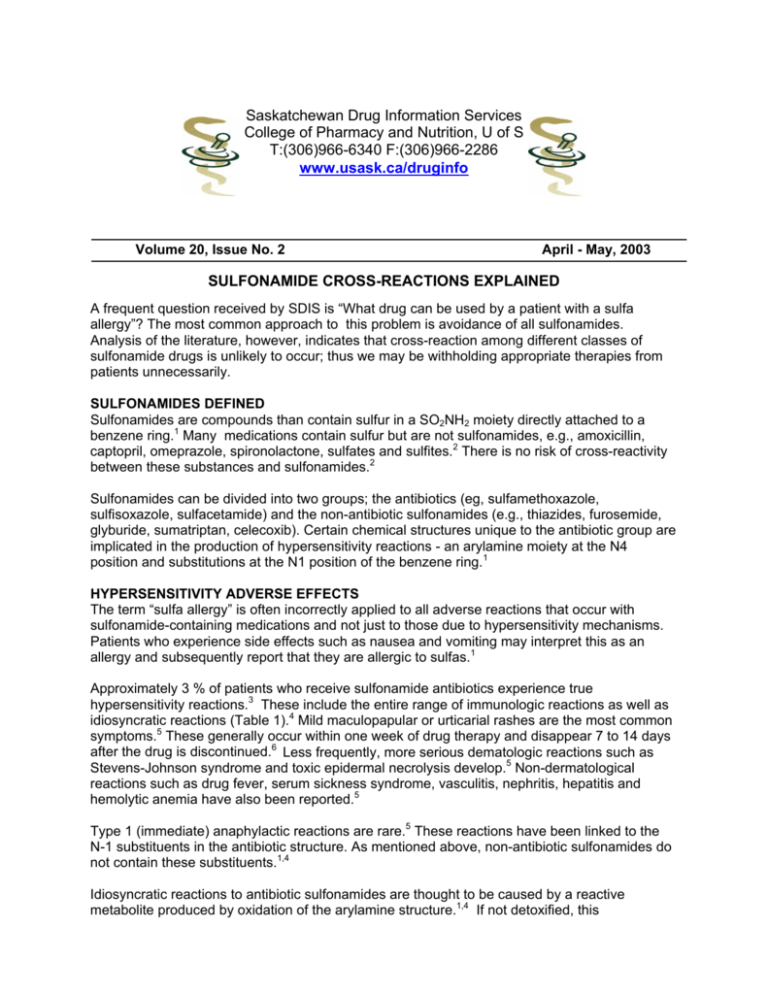
Saskatchewan Drug Information Services College of Pharmacy and Nutrition, U of S T:(306)966-6340 F:(306)966-2286 www.usask.ca/druginfo Volume 20, Issue No. 2 April - May, 2003 SULFONAMIDE CROSS-REACTIONS EXPLAINED A frequent question received by SDIS is “What drug can be used by a patient with a sulfa allergy”? The most common approach to this problem is avoidance of all sulfonamides. Analysis of the literature, however, indicates that cross-reaction among different classes of sulfonamide drugs is unlikely to occur; thus we may be withholding appropriate therapies from patients unnecessarily. SULFONAMIDES DEFINED Sulfonamides are compounds than contain sulfur in a SO2NH2 moiety directly attached to a benzene ring.1 Many medications contain sulfur but are not sulfonamides, e.g., amoxicillin, captopril, omeprazole, spironolactone, sulfates and sulfites.2 There is no risk of cross-reactivity between these substances and sulfonamides.2 Sulfonamides can be divided into two groups; the antibiotics (eg, sulfamethoxazole, sulfisoxazole, sulfacetamide) and the non-antibiotic sulfonamides (e.g., thiazides, furosemide, glyburide, sumatriptan, celecoxib). Certain chemical structures unique to the antibiotic group are implicated in the production of hypersensitivity reactions - an arylamine moiety at the N4 position and substitutions at the N1 position of the benzene ring.1 HYPERSENSITIVITY ADVERSE EFFECTS The term “sulfa allergy” is often incorrectly applied to all adverse reactions that occur with sulfonamide-containing medications and not just to those due to hypersensitivity mechanisms. Patients who experience side effects such as nausea and vomiting may interpret this as an allergy and subsequently report that they are allergic to sulfas.1 Approximately 3 % of patients who receive sulfonamide antibiotics experience true hypersensitivity reactions.3 These include the entire range of immunologic reactions as well as idiosyncratic reactions (Table 1).4 Mild maculopapular or urticarial rashes are the most common symptoms.5 These generally occur within one week of drug therapy and disappear 7 to 14 days after the drug is discontinued.6 Less frequently, more serious dematologic reactions such as Stevens-Johnson syndrome and toxic epidermal necrolysis develop.5 Non-dermatological reactions such as drug fever, serum sickness syndrome, vasculitis, nephritis, hepatitis and hemolytic anemia have also been reported.5 Type 1 (immediate) anaphylactic reactions are rare.5 These reactions have been linked to the N-1 substituents in the antibiotic structure. As mentioned above, non-antibiotic sulfonamides do not contain these substituents.1,4 Idiosyncratic reactions to antibiotic sulfonamides are thought to be caused by a reactive metabolite produced by oxidation of the arylamine structure.1,4 If not detoxified, this metabolite acts as a hapten (partial antigen) and binds to endogenous proteins to form a compound that triggers an immune reaction.2 Haptenated compounds may also be directly toxic to cells.4 The arylamine structure is not found in non-antibiotic sulfonamides. Table 1: Hypersensitivity Reactions to Sulfonamide Antibiotics1,4 Reaction type Mechanism Clinical reaction Gell-Coombs type I IgE antibodies (anaphylactic) urticaria, hypotension, angioedema, bronchospasm, anaphylaxis Gell-Coombs type II IgG or IgM (cytotoxic) thrombocytopenia Gell-Coombs type III Soluble immune complexes vasculitis Gell-Coombs type IV Sensitized Tlymphocytes contact dermatitis, fixed drug eruptions, photoallergic reactions Reactive metabolites fever, arthralgia, urticaria, morbilliform rash Immunological reactions Idiosyncratic reactions Serum sickness-like reaction Hypersensitivity syndrome reaction fever, malaise, rash, Stevens Johnson syndrome, toxic epidermal necrolysis, hepatitis, nephritis, pneumonitis CROSS-REACTIVITY AMONG SULFONAMIDES Cross-reactivity is the likelihood that a person who has had a hypersensitivity reaction to one drug will have the same reaction to a structurally similar drug. In theory, therefore, crossreactivity would be expected to occur among different members of the antibiotic sulfonamides but not between different classes of sulfonamides.1,4 In fact, reports in the literature documenting the safe use of sulfonamide medications in patients with a previous history of allergy to a sulfonamide outnumber reports of adverse reactions to two or more sulfonamides.1 A possible explanation for reports of sulfonamide cross-sensitivity may be the tendency of certain patients to be more susceptible to hypersensitivity reactions. Patients allergic to one antimicrobial drug are reported to be 10 times more likely to react to another non-structurally related drug than patients without a history of allergy.7 Thus, reactions to more than one sulfonamide may actually represent multiple allergies rather than a specific allergy to sulfonamides.7 RISK FACTORS FOR HYPERSENSITIVITY REACTIONS Patients with a history of previous reactions to other drugs, including non-sulfonamides, are at the highest risk of adverse reactions.1 Other risk factors include concurrent infection (appears to increase susceptibility to the effects of haptenation products)1, genetic predisposition (patients with the slow acetylator phenotype shunt more drug into the CYP oxidative pathway that forms the reactive metabolite) 8, and glutathione deficiency (glutathione plays an important role in detoxifying reactive metabolites) 9. MANAGEMENT STRATEGIES 1. History of severe life-threatening reaction to a sulfonamide (e.g., Stevens Johnson syndrone, toxic epidermal necrolysis, hepatotoxicity, anaphylaxis) is an absolute contraindication to the use of sulfonamides.6 2. A mild to moderate reaction is not necessarily a contraindication to the use of another class of sulfonamide but when available, a non-sulfonamide alternative of equivalent efficacy and safety is the preferred option.6 (Table 2) 3. If there is not an appropriate alternative, the patient should be started on a low dose of the sulfonamide and closely monitored.7 Patient counselling should include a discussion of the risks and benefits of the therapy.6 4. For patients with a demonstrated allergy to a necessary drug, e.g., loop diuretics in congestive heart failure, co-trimoxazole for Pneumocystis carinii pneumonia, desensitization can be tried.1,6 Desensitization involves starting with a very small amount of the drug and gradually increasing to the therapeutic dose. Sucessful protocols for co-trimoxazole, furosemide and sulfasalazine have been reported.1,6 Table 2: Commonly used sulfonamides and non-sulfonamide alternatives 2,6 Drug class Sulfonamide drugs * Alternative drugs * Antibiotics silver sulfadiazine, sulfacetamide, sulfadiazine, sulfadoxine, sulfamethoxazole, sulfapyridine, sulfisoxazole aminoglycosides, cephalosporins, clindamycin macrolides, nitrofurantoin, penicillins, fluoroquinolones, tetracyclines, trimethoprim Anti-inflammatory agents celecoxib, valdecoxib rofecoxib, non-selective NSAIDs Anti-glaucoma agents acetazolamide, brinzolamide, dorzolamide, methazolamide ophthalmic beta-blockers, prostaglandin analogues, apraclonidine, brimonidine, dipivefrin Diuretics bumetanide, chlorthalidone, chlorothiazide, diazoxide, furosemide, hydrochlorothiazide, indapamide, metolazone, torsemide amiloride, spironolactone, triamterene Hypoglycemics chlorpropamide, tolbutamide, glyburide, gliclazide, glimepiride acarbose, metformin, thiazolidinediones, nateglinide, repaglinide Inflammatory bowel disease therapy sulfasalazine 5-ASA products * Please note these lists do not include all sulfonamides or all possible alternatives. Suggested alternatives may not be appropriate or effective in all clinical circumstances. Prepared by Don Locke BSc, SPEP student and Karen Jensen, Drug Information Consultant REFERENCES 1. Tilles SA. Practical issues in the management of hypersensitivity reactions: Sulfonamides. South Med J 2001:94:817-824. 2. Allen J. Which medications to avoid in patients with sulfa allergy? Pharmacist’s Letter 2000;July:Detail Document 160708. 3. Kucera CM, Greenberger PA: Adverse drug reactions: treatment and prevention. Hosp Med 1996;32:11-24. 4. Knowles S, Shapiro L, Shear, NH. Should celecoxib be contraindicated in patients who are allergic to sulfonamides? Revisiting the meaning of ‘sulfa’ allergy. Drug Safety 2001;24:239-247. 5. Bond CA. Skin disorders I. Applied Therapeutics: The Clinical Use of Drugs. Koda Kimble MA, Young L (eds). Vancouver, Applied Therapeutics, 5th Ed, 1991, p 64-18. 6. Anonymous. Sulfonamide allergy and cross-allergenicity - Answers to common questions. New Drugs/Drug News, Drug Information Service Newsletter, Ontario College of Pharmacists 1996;14: May/June. 7. Sullivan T. Cross-reactions among furosemide, hydrochlorothiazide and sulfonamides. JAMA 1991;265:120-121. 8. Rieder MJ, Shear NH, Kanee A et al. Prominence of slow acetylator phenotype among patients with sulfonamide hypersensitivity reactions. Clin Pharmacol Ther 1991;49:13-17. 9. Rose EW, McCloskey WW. Glutathione in hypersensitivity to trimethoprim/ sulfamethoxazole in patients with HIV infection. Ann Pharmacother 1998;32:381-383.
